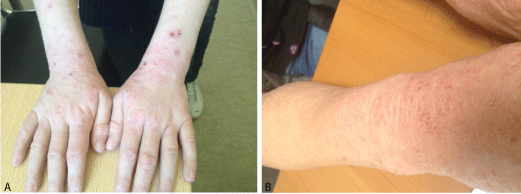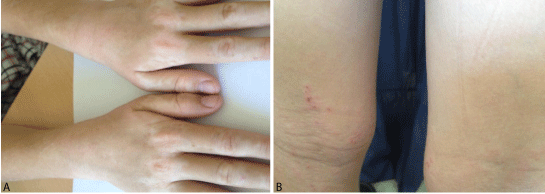
Case Report
Austin J Pulm Respir Med 2015;2(1): 1020.
Severe Atopic Dermatitis and Respiratory Allergies Controlled by Cyclosporine Monotherapy in a Child: A Case Report
Staikuniene Jurate1* and Staneviciute Jurate2
1Department of Pulmonology and Immunology, Lithuanian University of Health Sciences, Lithuania
2Department of Histology and Embryology, Lithuanian University of Health Sciences, Lithuania
*Corresponding author: Staikuniene Jurate, Department of Pulmonology and Immunology, Lithuanian University of Health Sciences, Eiveniu 2, LT 50009 Kaunas, Lithuania
Received: September 16, 2014; Accepted: December 30, 2014; Published: February 11, 2015
Abstract
Atopic dermatitis is one of the most common skin diseases in childhood. It is characterized as inflammatory and chronically relapsing skin disease with skin dryness, erythema, crusting, and lichenification. Severe atopic dermatitis management can be challenging as some patient fail to respond to standard treatment strategies. We presented the case of 10 years old boy who suffered from severe brittle atopic dermatitis from infancy later accompanied by asthma and allergic rhinitis with sensitization to food and aeroallergenes. From the first point of view it seems as a trivial case in daily practice of allergists, except that multiple allergies were successfully and safely controlled by monotherapy with systemic cyclosporine for 6 months in a young boy and the positive effect was maintained after the drug was stopped.
Keywords: Atopic dermatitis; Allergic rhinitis; Aeroallergenes; Cyclosporine; Asthma; Anterior rhinoscopy; Monotherapy
Clinical Presentation
A 10 years old boy was referred to the tertiary university center for the consultation of allergist-clinical immunologist because of severe Atopic Dermatitis (AD) and concomitant asthma, Allergic Rhinitis (AR). Patient had a family history of atopic father with AD and brother with AR. Severe AD was diagnosed at 3 months of age with SCORAD evaluation of 55 although skin rashes started from 3 weeks of age since breastfeeding was stopped. No allergy tests were performed at that time. Standard treatment modalities for the management of severe atopic dermatitis consisted of empirically chosen hypoallergenic infant formula Neocate, emollients, local corticosteroids, Ac. Fucidici and antihistamine treatment. In early childhood (at age 2) wheezing attacks presented, at 4 years age asthma and AR were diagnosed with concomitant severe AD (SCORAD 83). To manage these condition treatment of emollients, local corticosteroids, pimecrolime, systemic antihistamines, intranasal beclomethasone, salbutamol inh., montelucast were prescribed. Nevertheless, patient had a history of frequent recurrent wheezing attacks, upper respiratory tract and Herpes simplex skin infections, secondary pyodermia caused by Str. pyogenes, S.aureus which were managed by multiple courses of topical and systemic antibiotics. Despite adequate treatment patient presented with severe atopic dermatitis and concomitant asthma and AR symptoms. The physical examination during consultation revealed severe skin rashes, lichenification, crusting, SCORAD 64.5 (Figure 1) and signs of infection: pyodermia and eczema herpeticum on the neck. Anterior rhinoscopy showed swollen and pale nasal mucosa, groups of eosinophils on nasal smear cytology. No abnormalities in lung auscultation and spirometry were found. The blood analysis revealed increased eosinophil count to 21.1%. Immune system parameters, such as serum IgA, IgM, IgG levels, Neutrophil Function Test (NBT) were within normal ranges. Follow up laboratory test assessments showed extremely high IgE levels and polysensitisation to food and inhalant allergens compared with the initial evaluation (at 2 years of age) (Table 1).
Parameter
2 years of age
4 years of age
10 years of age
sIgE to food allergens (class)
negative
Positive to : cheese (1 class), milk (2), almond (4), peanut (2), soja (2), walnut (1), wheat (2)
Not performed
sIgE to inhalant allergens (class)
negative
positive to: D.pteronyssinus (4), D.farinae (4), Alternaria (1), Cladosporium (1), Penicilium (1), cat (4), cow (4), dog (4), horse (4), birch (4), hazelnut (4), grass (4), mugworth (3), nettle (1)
Not performed
Skin prick tests
Not done
Not done
positive to birch, grass mix, mugworth, soja, negative to house dust mites, cat, fish, wheat
Atopy patch tests
Not doe
Not done
Negative to egg and wheat
Total IgE (IU/ml)
65.2
16310.2
4412.2
Eosinophils in blood (%)
18
15
21.1
Table 1: Allergen sensitization profile and laboratory assessments by age.

Figure 1: Severe atopic dermatitis, skin rashes, lichenification, crusting before systemic cyclosporine treatment (SCORAD 64,5) (A. Hands, B. Legs).
The patient was initially treated with acyclovir 5days course for HSV infection. A combination of montelucast and cetirizine tablets and intranasal mometasone started with topical treatment with emollients, Cr. Pimecrolime and Ac.Fucidici. As the combined treatment was not effective, multiple allergies had a significant impact on the patient's life, immunosuppressive therapy with cyclosporine 3 mg/kg/daily (100mg) was initiated 2 weeks later. After 6 months of cyclosporine therapy (maintenance dose 75 mg/d), SCORAD dropped down to 26.5 - 30.5 (Figure 2), patient had no asthma symptoms, no infections only intermittent allergic rhinitis symptoms with no need for treatment. Laboratory tests revealed reduced inflammatory markers: IgE 2325kU/l, WBC 1330 cells/mm3, eosinophils 3.7%. Drug safety has been assessed regularly by a set of laboratory tests: total blood count, serum creatinine, urea, liver enzymes. All the tests were within normal range and no hypertension or other side effects were observed. The cyclosporine monotherapy was stopped, and the positive effect was maintained with no need for other systemic therapy on the follow-up of next 6 months.

Figure 2: Significantly reduced signs of atopic dermatitis on cyclosporine monotherapy, SCORAD 30.5 (A. Hands, B. Legs).
Discussion
We presented the case of 10 years old boy who suffered from severe brittle atopic dermatitis from infancy later accompanied by asthma and allergic rhinitis with sensitization to food and aeroallergenes. From the first point of view it seems as a trivial case in daily practice of allergists, except that multiple allergies were successfully and safely controlled by monotherapy with systemic cyclosporine for 6 months in a young boy and the positive effect was maintained after the drug was stopped.
Atopic dermatitis is an inflammatory, pruritic, chronic or chronically relapsing skin disease that occurs frequently in families with other atopic diseases [1]. It is one of the most common skin diseases, which affects up to 20% of children and 1-3% of adults in most countries of the world [2]. Atopic dermatitis is often the first step in the development of other atopic diseases as rhinitis and/or asthma [3]. Clinical features of atopic dermatitis include skin dryness, erythema, oozing and crusting, and lichenification. The goals of treatment are to reduce symptoms (pruritus and dermatitis), prevent exacerbations, and minimize therapeutic risks. There is controversy regarding whether environmental or food allergies are exacerbating factors in patients with atopic dermatitis [4]. Some recent data have revealed that aeroallergens may elicit eczematous skin lesions, furthermore high percentage of patients with AE have positive atopy patch tests (30-50%) [3,5]. In our presented case in early childhood blood test didn't reveal food or aero allergen sensitization, but later in life polysensitization occurred. Our presented case supports the data that atopic dermatitis is the first step of "atopic march" followed by sensitization to inhalant allergens and development of respiratory allergic symptoms. There is a lack of evidence that dietary interventions are helpful in reducing the severity or preventing flares of atopic dermatitis in unselected patients [6]. Although approximately 50% of children with atopic dermatitis may have positive skin prick tests or specific IgE to one or more food allergens (in particular, cow's milk, egg, wheat, and peanut), food sensitization is clinically irrelevant in most cases [7]. In our presented case patient was on elimination diet (Neocate amino acid formula), as food allergy was revealed, but no clinical significant benefit was observed. We speculate that other food and aero allergy could be important triggering factors that made severe atopic dermatitis therapy resistant later in his life.
Atopic dermatitis standard treatment involves hydration of the skin, pharmacologic treatment of skin inflammation using topically applied corticosteroids or topical calcineurin inhibitors as second-line therapy. Adult patients with moderate to severe atopic dermatitis that is not controlled with optimal topical therapy may require phototherapy or systemic immunosuppressant treatment to achieve adequate disease control [8,9]. Evidence on the efficacy and safety of systemic immunosuppressant for children is limited. Oral cyclosporine is not recommended in infants and young children with atopic dermatitis. In older children and adolescents, the use of cyclosporine should be reserved to the most severe cases [10].
In our presented case patient have been treated with prolonged courses of topical, systemic glucocorticoids and antibiotics. Despite adequate treatment severe atopic dermatitis persisted and failed to respond to topical and systemic treatment. As the quality of life of the patient was significantly affected, the initiation of immunosuppressive therapy was decided. In our presented case cyclosporine was started 3 mg/kg/d (100mg) and the dose was adjusted according to the response to the lowest effective dose and after 6 months of cyclosporine therapy (maintenance dose 75 mg/d) lead to clinically significant improvement and to SCORAD 26.5 - 30.5. Once stable clinical improvement was achieved, cyclosporine was withdrawn and treatment with topical corticosteroids and emollients resumed. During whole treatment patient was monitored by measuring blood pressure and serum creatinine, urea, glycaemia, liver enzymes. No significant elevations were observed. Overall laboratory test revealed reduced blood inflammatory markers: IgE 2325kU/l, Eosinophils 3.7%. In addition immunosuppressive treatment had a beneficial effect also on respiratory symptoms, our patient had no asthma symptoms, only intermittent allergic rhinitis symptoms with no need for treatment. There was no recurrency of viral and bacterial skin infections, and this effect can be explained by reduced skin inflammation and improved barrier function and local nonspecific immunity.
Conclusion
Our presented case suggest that skin inflammation in severe AE should be treated effectively, systemic therapy should be tried and can lead to an improvement of multiple allergies, including asthma and AR. In our presented clinical case monotherapy with cyclosporine efficiently and safely controlled multiple allergies- severe atopic dermatitis, asthma and allergic rhinitis in a 10years old child. This successful case supports the concept of using cyclosporine as a reserved additional medicine for the treatment of the severe atopic dermatitis in children, but there are insufficient clinical data to be confident of the safety. The further clinical investigations are needed to be conducted with adequate accuracy to provide guidance using this therapy for severe atopic dermatitis in children.
References
- Johansson SG, Hourihane JO, Bousquet J, Bruijnzeel-Koomen C, Dreborg S, Haahtela T, et al. A revised nomenclature for allergy. An EAACI position statement from the EAACI nomenclature task force. Allergy. 2001; 56: 813-824.
- Williams HC. Atopic Dermatitis. The Epidemiology, Causes and Prevention of Atopic Eczema. Cambridge University Press, Cambridge, UK. 2000; 41-59.
- Ring J, Alomar A, Bieber T, Deleuran M, Fink-Wagner A, Gelmetti C, et al. Guidelines for treatment of atopic eczema. J Eur Acad Deramatol Venereol. 2012; 26: 1045-1060.
- Jonathan MS. Role of allergy in atopic dermatitis (eczema), An Update. Scientific Press. 2014.
- Darsow U, Vieluf D, Ring J. Evaluating the relevance of aeroallergen sensitization in atopic eczema using the tool 'atopy patch test': a randomized, double-blind multicenter study. J Am Acad Dermatol. 1999; 40: 187-193.
- William LW, William H. Treatment of atopic dermatitis (eczema). An Update. Scientific Press. 2014.
- Kjaer HF, Eller E, Host A, Andersen KE, Bindslev-Jensen C. The prevalence of allergic diseases in an unselected group of 6-year-old children. The DARC birth cohort study. Pediatr Allergy Immunol. 2008; 19: 737-745.
- Roekevisch E, Spuls PI, Kuester D, Limpens J, Schmitt J. Efficacy and safety of systemic treatments for moderate-to-severe atopic dermatitis: a systematic review. J Allergy Clin Immunol. 2014; 133: 429-438.
- Sidbury R, Davis DM, Cohen DE, Cordoro KM, Berger TG, Bergman JN, et al. Guidelines of care for the management of atopic dermatitis: section 3. Management and treatment with phototherapy and systemic agents. J Am Acad Dermatol. 2014; 71:327-349.
- Harper JI, Ahmed I, Barclay G, Lacour M, Hoeger P, Cork MJ, et al. Cyclosporin for severe childhood atopic dermatitis: short course versus continuous therapy. Br J Dermatol. 2000; 142: 52-58.